Early Hand on Book Half Escudo Gold Coins 1825-1870
by Brett Irick
At the recent USMexNA Convention and Education Forum I displayed the 96%+ complete Crowe Lake Professional Coin Grading Service registry set of half escudo gold coins, the all-time finest known set of these coins. This set is collected by date, assayer, and mint mark, aka DAM, plus overdate varieties and includes additional dates and varieties not required by PCGS. Assembling this set has taken sixteen years. It is one of two known reasonably complete sets of these coins.
Acquiring the four coins required to complete this set will be difficult since there are only one or two known of each.
Assembling this set of 100 plus coins has been an extreme challenge. Joe “Pepe” Flores, a senior Mexican numismatist, advised “half escudos are one-third scarce to rare, one-third very rare and one-third so rare that you will be lucky to see one and probably not be able to buy it. The only thing rarer than the coins are the number of people that collect them.”
In many cases the only available coins are mint errors, cleaned, damaged and/or ex-jewelry. Now months can pass without an opportunity to upgrade this set. The most common coin is the 1825 Mexico City of which 200 to 250 are known. “Large numbers were not required since most Mexicans would not see that much money in months.” There are around 3,000 coins of the series known, and the estimated survival rate is under one-quarter of a percent.
This series began in 1825 when gold became available and when public demand for the coins existed. They represent a continuation of the half escudo coins issued by the royalist Spanish colonial government. The series ended in 1870 with the introduction of the Republic of Mexico peso decimal series of gold coins. These coins were particularly useful when travelling since they were smaller and lighter than the equivalent value silver coin. They could be well hidden from banditos or bandits in personal belongings. With limited exceptions all of the mints that made these coins were operated by non-government lessees from Europe.
What is a Half Escudo?
The half escudo gold coin is the smallest coin of the five hand on book series and is equal to one United States gold dollar and is equal to eight reales or one United States dollar in silver. My research has identified die orientations of each issue plus sixty obverse dies and sixty-three reverse dies. Plus, it has been discovered that Mexico City used more than one die pair for several dates. as many dies were used for more than one year. Around two thirds of the dies for this series were used at the Mexico City mint and the balance at the six regional mints.
Half Escudo Design
Mexican law established the design of these coins but there were no sketches of exactly what they should look like.
There were four different major design interpretations for each side. The law required slanted edge reeding but did not specify //// or \\\\. The law did not specify die orientation /\\/ coinage or medal /\/\. Minor changes were made as the series progressed. Law required the dies to be made at the Mexico City mint. However, die delivery could take years due to lack of tool steel and limited ability to move them safely to the regional mint customers. The regional mints, with the exception of Guadalajara, out of necessity, had most or all their dies made in Europe.
Obverse:
Legend: REPUBLICA MEXICANA (Mexican Republic)
Devices: Shield of Mexico with Eagle standing on a cactus tree with snake gripped in mouth and right talon with Lake Texcoco in the background under the cactus. Oak branch left and olive branch right signifying strength and peace.
Some Mexico City issues have the oak branch and olive branch reversed. Stops (dots) before and/or after legend are not always present.
Reverse:
Legends: LA LIBERTAD EN LA LEY (Liberty under Law), 1/2E, mint, date, two or three assayer initials and 21 Qs. (21 Qs = 21 of 24 karats pure or 87.5% gold). Stops (dots) in various locations. Stop, five-pointed star or six-pointed star before 1/2.
Devices: Hand holding a pole with a Phrygian cap pointing to a book of law. The Phrygian cap is identified as an ancient symbol of freedom from southern Europe to Persia.
Edge: Slanted reeding //// or \\\\ depending on the mint. In 1834 Durango used the •)•)•)• silver coin edge on part of their 1834 production.
Die orientation: /\\/ coinage and /\/\ medal depending on the mint and, for Guadalajara, the year of production.
Specifications and Coining Method:
Weight: 1.692 grams, 0.0476 ounces actual gold weight
Composition: 0.875 gold and 0.125 copper and other metals, primarily silver.
Diameter: 14 mm Thickness: 0.75 mm
Designers and Engravers: Unknown.
Coining method: Most had the edge raised by a casting machine and were then struck on a human powered screw press. Some later dates were made on externally powered mechanical presses with the edge made by a closed collar in the press.
How Many were Made?
These coins were made when gold was available and there was local demand for them. Between gold shortages and lack of demand the mintages were usually low and sporadic. The number of coins minted is unknown as mintages were not recorded. The mints only reported the number of total escudos of all five denominations of gold coins that they produced annually. Most of these records have been lost. In addition, the privately operated mints were known to underreport their production due to the twenty percent tax on coins owed by the mints to the Mexican government.
Richard Long wrote the book Gold Coins of the Early Mexican Republic 1823-1873 that was published in 2004. In it he compiled the number of public sales of each date, assayer and mint mark, from around 1940 to 2003. This compilation provides the basis of the relative scarcity and condition range for each coin. Since 2004, NGC and PCGS population reports have matured for these coins and these provide evidence that agree with Long’s book.
Mintages could be as low as thirteen and a high mintage would have been 2,000. The exception was 1825 Mexico City where the mintage was likely over 10,000 due to receipt that year of a 2,500,000 escudo gold loan from Europe. This and other loans resulted in much higher than usual gold coin mintages. The low mintage estimates of thirteen and multiples of thirteen could relate to the thirteen-coin arras representing Jesus and the Apostles that were given by the groom to the bride at their wedding ceremony as a symbol of trust..
Condition
These coins are customarily graded on the Sheldon 1 to 70 scale. A 1 is a Poor condition coin and a 70 is a perfect Uncirculated. Coins of this series that are above the grade of Almost Uncirculated 50 and not damaged are almost always rare to very rare. Fewer than 10% of the third party graded coins grade above Mint State 64. The third party graded coins represent around 25% and the highest quality of the survivors of the issue. Many surviving coins are cleaned and/or damaged. Until the 1960s, many collectors of Mexican coins cleaned their coins to make them shiny. Hairline damage is common on half escudos. King Farouk of Europe was known to clean his gold coins with a toothbrush and a paste made of baking soda, toothpaste, other chemicals, and water. Fortunately, early major collectors of these coins such as Amon Carter, Louis Eliasberg, Newman, Norweb and John J. Pittman were careful conservators of their collections.
Mexico during the Early Republic Escudo Coinage Era
Mexico was left destitute from the 1810 to 1821 War of Independence from Spain. Little commerce was possible. Almost the entire economy was based on mining and the minting of gold and silver coins primarily for export to pay for imported goods and government debt, and many of the best mines were fl ooded at the end of the revolution. Draining and repairing the mines required years.
A well-intended 1820s law to exile residents born in Spain had the unintended consequence of three centuries of builtup wealth being removed from the country. There were no true banks. The Roman Catholic Church of Mexico was still the local major source of financing. During his 1820 to 1830 reign British King George IV encouraged European banks to loan money to Mexico. The resulting loans helped fix the Mexican economy. The King also encouraged British engineering and foundry companies to work in Mexico. One result was that Marshall and Manning moved to Mexico and became the lessees of the great mints of Guanajuato and Zacatecas. The Soho mint provided modern equipment to the mints at Chihuahua, Culiacán, Guanajuato, Mexico City, and Zacatecas.
Much did not go well. By 1836 the government of Mexico was bankrupt and owed principal and interest payments on debt. They also started to lose over half of their territory, first with the Texas secesssion in 1836, then as a result of the 1846-1848 Mexican American War, and lastly through the 1853 Gadsden purchase of the southern parts of Arizona and New Mexico. Both the 1848 and 1853 treaties provided Mexico with financial compensation from the United States.
Law and order were nearly non-existent outside of municipalities. Marauding groups of armed men roamed the countryside. There was continued civil factionalism and unrest in many areas. and during this time, regional mints were opened to avoid the need to transport ore at great risk of loss for refining and coining in Mexico City. Regional mints remained open and were modernized over time.
France officially invaded in 1838 and again in 1861 to collect debt owed but with the real intention to gain control of the profitable areas of the economy. Maximilian was installed by France as emperor in 1864 but deposed by Republican government loyalists in 1867 after the 1866 French withdrawal and the Republic of Mexico was reestablished.
Production
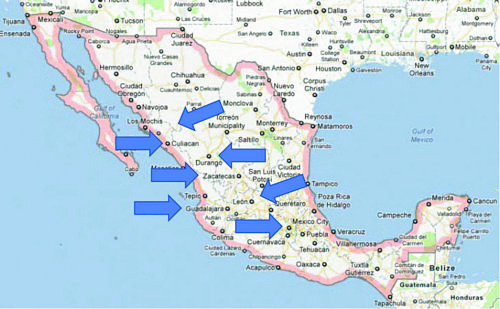
The arrows point to the seven cities where the half escudo coins were made. Guadalupe y Calvo is the upper slanted arrow.
Guanajuato is the lower slanted arrow.
Culiacan
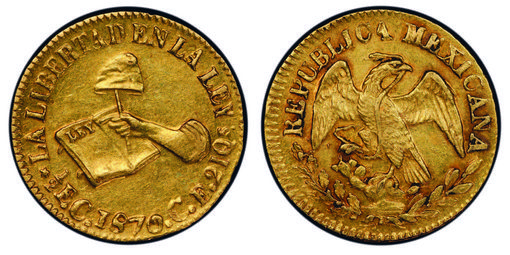
This coin has the Sonora style eagle used on the late coinage of Culiacán and Guadalupe y Calvo. The dies were likely made by the Soho mint in England. This die pair were in use from 1850 to 1870. There are three known 1870 C CE Culiacán. This coin is Almost Uncirculated 55 and it is tied finest with one other coin. Culiacán was the only mint to issue 1870 half escudos – the last year of the series.
The Mexican government approved this west coast mint to reduce rampant outbound smuggling of unrefined and hence untaxed gold and silver ore. The Culiacán mint operated from 1846 to 1897. The mint equipment was built in England by Finlay, Hodgson and Company and the Soho mint and was shipped to Mexico in 1833. Why production did not start until 1846 is unknown. The Culiacán mint, operated by lessees, was a moderate producer of gold coins and a heavy producer of silver coins. Small denomination coins were produced in small numbers for local circulation resulting in some extreme rarities.
Culiacán (C mint mark) produced half escudos with twelve dates from 1848 to 1870. Long recorded 321 sales. The edge reeds are //// and the die orientation is /\\/ coinage. Two pairs of dies were used. The first pair were used from 1848 to 1853 with redating. The obverse used a variety of a Mexican facing eagle style and the dies were likely made at the Soho mint in England. After the Guadalupe y Calvo mint closed, their Sonora eagle dies were transferred to this mint. The date, assayer and mint mark were changed, and Culiacán mint use started in 1854. With redating, these dies were used until 1870. Great rarities are 1856, 1866 and 1870 of which there are three known of each.
Durango
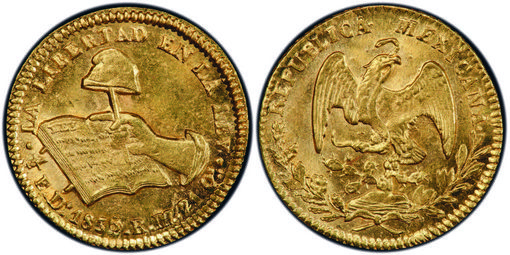
This coin has the Paris style eagle used on the early coinage of Durango along with a much larger than usual book of law. This die pair was used from 1833 to 1855. The dies for this design were likely made in England or France. The 1836 D° RM/L Durango is the most common half escudo produced by Durango. Graded Mint State 65 it is the finest known half escudo for the date and the mint. The nearly full hand/book and snake detail is an extraordinarily good full strike seldom seen in this series of coins from any mint. This set started in 2006 with this coin.
The Durango mint was opened by Royalists in 1811 during the Mexican War for Independence. It made large quantities of gold coins from 1834 until 1843 and again in 1850. After 1850 gold production was dramatically smaller resulting in great rarities. Silver coinage at this mint was always large. The Durango mint closed in 1895.
Durango (D° mint mark) produced half escudos with twenty-one dates from 1833 to 1864. Long recorded 342 sales. The edge reeds are \\\\ and the die orientation is /\\/ coinage. A number of 1834 were made with the •)•)•)• silver coin edge reeding. The 1834 and 1834/1 in my collection have the •)•)•)• silver coin edge reeding. The 1834/3 has the intended \\\\ edge. Durango is recognized for having the poorest quality half escudo coins. Three obverse dies and four reverse dies were used. The first two obverses have the Paris eagle style. These first two die pairs were probably made in England or France. The last two die pairs, with a Mexican facing eagle style, were likely made at the Soho mint in England and put into service in 1859 and 1861 retiring dies used since the 1830s. The 1850, 1851 and 1852 issues are the only coins of the half escudo series to use three assayer letters – JMR. The uses of three letter could be due to JMR predecessor’s RM initials. Great rarities in my collection are 1852 four known, 1847/38 and 1853/33 three known and 1864 two known. All four are finest known. The Mint State 65 1836/1 in my collection is tied with two coins of the same overdate for the highest condition known from the Durango mint.
Guadalajara
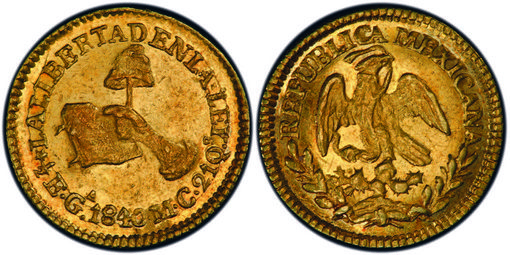
This coin has the facing eagle style used on all of Guadalajara half escudo and the half escudo coinage of all seven mints for at least some of their half escudo production. All known Guadalajara half escudo dies were made at the Mexico City mint. This 1840 Gª MC Guadalajara is the finest of two known. Still uncatalogued, the only two public sales occurred in 2011 and 2016. Although extremely rare the hand on book die has significant die cracks in the legend. This suggests that the mintage planned was small and that the die was used in an unhardened soft condition that would cause rapid wear. This coin is a stopper for collecting the series by assayer initials. MC is a one-year assayer.
Like Durango, the Guadalajara mint was opened by Royalists in 1812 during the Mexican War for Independence. This mint was authorized by the King of Spain sometime in the 1700s. The Republic government took over the mint in 1824 and continued operations until 1895. The Guadalajara mint was a small producer of gold coins and a large producer of silver coins.
Guadalajara (Gª mint mark) produced half escudos with sixteen dates from 1825 to 1861. Long recorded 120 sales. With sixteen dates and only 120 sales collecting Guadalajara half escudos is the most difficult of any mint. The edge reeds are \\\\. The die orientation is /\/\ medal up to 1842 and /\\/ coinage from 1847 until the end of production in 1861. Six obverse and nine reverse dies were used. All were made at the Mexico City mint. Illustrated above is the finest of the two known 1840. This coin was first owned by Richard Rosholm, a founding member of the Chicago Numismatic Roundtable in the 1940s, for under $50. He later sold it to now deceased Albert Hall. His widow found it in an ashtray in which Hall placed coins that he thought were counterfeit. Thankfully his widow delivered all his material to Numismatic Auctions where it was auctioned as an ungraded coin in 2016. It is now in a PCGS MS62 holder. Additional great rarities are the three known 1842 and 1847. The 1842 is finest known and the 1847 is tied with one coin for finest known. There are four known 1850 of which the coin displayed is second finest. The one known 1826 and one of the two known 1834 and 1838 are needed to complete this set. The not cataloged 1826 was auctioned by Stacks around 10 years ago. An Extra Fine 1834 was sold on eBay in 2010 for $1,625, a bargain.
Guadalupe y Calvo

This coin has the facing eagle style used on the 1846 to 1848 production of Guadalupe y Calvo. These dies were likely made at the Soho mint in England. The 1847 GC MP Guadalupe y Calvo shown is relatively common with around 40 known and in Almost Uncirculated 58. This coin is tied with one other for finest known.
This mint operated from 1844 to 1852 and was operated by the same lessee as the nearby Culiacán mint. This mint was located inland to the northeast of the Culiacán mint in the state of Chihuahua. It had moderate production of gold and silver coins. The mint closed prematurely when the local Rosario ore vein played out due to reaching the water table without the means to pump the water out. After mint closure a significant amount of the mint equipment was transferred to Culiacán including the Sonora style eagle half escudo dies that were reworked for use there.
Guadalupe y Calvo (GC mint mark) produced half escudos with five dates from 1846 to 1851. Long recorded 136 sales.
The edge reeds are //// and the die orientation is /\\/ coinage. The mint used two pairs of dies. The first die pair was used from 1846 to 1848. The obverse used a Mexican facing eagle style, and the dies were likely made at the Soho mint in England. The second pair with a larger Sonora eagle were likely made in England and probably at the Soho mint. They were used in 1850 and 1851. This pair of dies were transferred to Culiacán mint and were first used there in 1854. My Mint State 64 1851 is tied with two other 1851 for the highest condition known for the Guadalupe y Calvo mint. There is one known of the 1850. It is one of the four coins needed to complete my set.
Guanajuato

This coin has the facing eagle style that was used on Guanajuato coinage from 1845 to 1853. The die pair was likely made at the Soho mint in England. REPUBLICA is misspelled REPUBLLCA. This 1853 G° PF Guanajuato half escudo in Mint State 63 is the finest known for the date and the mint.
The Guanajuato mint was started by Father Hildago in 1810 during the Mexican War for Independence and taken over by Royalists in 1812. The Republic government took over the mint in 1824 and production continued until 1900. During most of the Guanajuato mint operation it was the largest producer of gold and silver coins.
Guanajuato (G° mint mark) produced half escudos with eleven dates from 1845 to 1863. Long recorded 390 sales. The edge reeds are \\\\ and die orientation /\\/ coinage. Four obverse and four reverse dies were used. The first pair of dies were used from 1845 to 1853 and have the Mexican facing eagle style of the Guadalupe y Calvo dies used in 1846 to 1848 with REPUBLICA misspelled REPUBLLCA. They were likely made at the Soho mint in England. The next two pairs of dies were also likely made at the Soho mint and were used from 1857 to 1862. The last die pair used in 1863 are of unknown origin. The two 1863s in my collection with two different assayer initials are the only third party graded considered genuine examples of this date. The 1853 pictured above is the finest known Guanajuato half escudo.
Mexico City
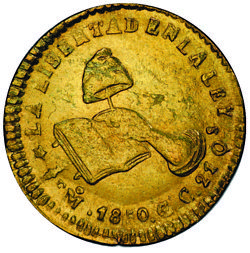
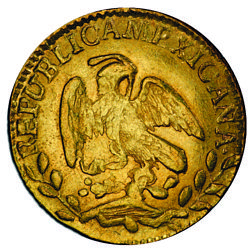
This coin has the facing eagle style used on Mexico City coinage with minor variations from 1825 to 1869. The dies were made at the Mexico City mint. In 1848 smaller size letters were used on both sides for the first time. This 1850 M° GC Mexico City half escudo is the only date known with hybrid letter sizes – large letters on the eagle obverse and small letters on the hand on book reverse. This Mint State 61 coin is finest known of the five to seven known. The next highest third party graded coin is an Extra Fine 40.
The Mexico City mint was established in 1536 and was the first mint in the New World. During the Republic escudo era it was a large producer of gold and silver, except for gold in the 1830s and 1840s when gold mintage was at an alltime low. Unlike the other mints, the Federal government controlled the mint until 1847 when it was leased. This mint remained in operation until 1982 when production was transferred to San Luis Potosí. The last mint building, built in the 1700s, is currently occupied by the Museo Nacional de las Culturas.
Mexico City (M° mint mark) produced half escudo coins with thirty-four dates from 1825 to 1869. There is an 1825 5 over 4 overdate that suggests that dies were prepared for a 1824 coinage that did not occur. Long recorded 1,552 sales making this mint issue the most prolific survivor of the series. The edge reeds are \\\\ and the die orientation is /\/\ medal. All known dies were made at the Mexico City mint. Forty-one obverse and forty-one reverse dies were used. In 1840 four different obverse and reverse dies have been discovered. This could mean that up to sixteen die pairs exist for 1840. Four 1840 die pairs have been discovered to date. The oak and olive branches are transposed in 1833, 1834, and one 1840 obverse die. More die pair transposed branch discoveries are possible. Small font letters appeared for the first time in 1848 and were used until the end of production in 1869. A hybrid font 1850 die pair – reverse small letters and obverse large lettered - was discovered during exhibitor research. This 1850 has an obverse eagle die not seen on previous dates. This die is likely an 1848 or earlier leftover that the mint did not want to go to waste. Also in this collection is second finest known 1835 and the finest known 1850 of which there are five to seven of each. There are fewer than ten known of the damaged 1839 in the collection.
Zacatecas
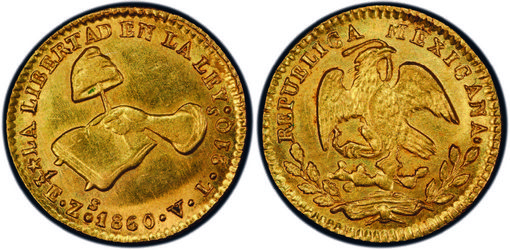
This coin has the facing eagle style used for both years of Zacatecas production. The dies were likely made at the Soho mint in England. This 1860 Zs VL Zacatecas half escudo in Mint 63 is tied fi nest known for the date and tied fi nest known for the mint.
Royalist minting operations started in Zacatecas in 1810 during the Mexican War for Independence. During the war it was operated by both the Insurgents and the Royalists. The State of Zacatecas controlled the mint until 1836 when the Federal government took control of the mint. In 1842 the mint was leased to Manning and Marshall. They successfully operated the mint until 1874. Manning and Marshall also operated the nearby Guanajuato mint. Zacatecas was a large producer of silver. This mint only made significant gold coinage in 1859, 1860 and 1861. The Zacatecas mint was closed in 1905.
Zacatecas ( Zs mint mark) produced half escudos in only two years – 1860 and 1862. Long recorded 91 sales. Although each date is relatively common, they are not regularly available on the market. For those collecting a type set of the seven half escudo mints the Zs coin is usually the last to be acquired. The edge reeds are //// and the die orientation is /\\/ coinage. The one die pair used has a Mexican facing eagle and was likely made at the Soho mint in England. The 1860 illustrated above is tied finest known for the date and tied with one 1862 for finest known of the mint.
References
Buttery, T. V. and Hubbard, Clyde, A Guidebook of Mexican Coins 1822 to date, Whitman, 1971.
Davis, Steve, Oral history of Rosholm/Hall 1840 Guadalajara half escudo: 2016
Doty, Richard, The Soho Mint and the Industrialization of Money, The British Numismatic Society, London, 1988.
Las arras matrimoniales – wedding coins https://www.weddingwire.com/wedding-ideas/mexican-wedding-traditions#
Long, Richard A., Gold Coins of the Early Republic of Mexico 1823-1873, Wegfred Publications, North Bend, Oregon, 2004.
Poucher, Ralph, Coin Facts. An extensive series of internet articles published on www.mexicancoinmagic.com during the first decade of the 2000s. Poucher entitled many of the articles The Foxlair.
Pradeau, A. F., Historia Numismatica de México de 1823-1897, Superior Stamp and Coin, Beverly Hills, California, 1997.
My complete collection can be viewed by web search PCGS Crowe Lake Mexico or at https://www.pcgs.com/setregistry/mexican-milled-coinage/mexican-first-republic/mexican-1-2-escudo-basic-set-circulation-strikes-1825-1870/alltimeset/286220
